The Misfits
1 February 1961
A Valentine For Marilyn
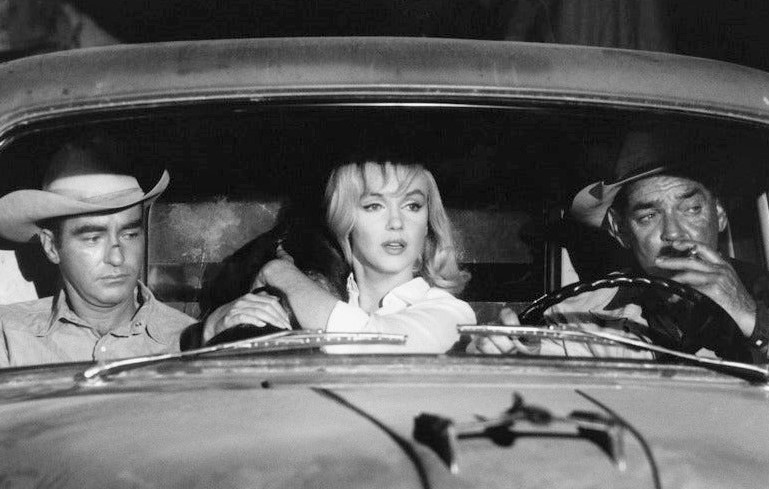
Rosalyn Tabor, just thirty years old, a former dance instructor, moved to Reno from points East to attain a fast divorce from her present but inattentive husband, Raymond. She moved into a local boarding house managed by Isabelle Steers, who is like a professional witness for women seeking a divorce in Reno, only she doesn’t get paid. Isabelle has been a witness in seventy-six prior divorces, soon to be seventy-seven. Roslyn is a man magnet and many of the men who want to meet her often do so by intentionally hitting her car with theirs. The movie begins as automobile mechanic and former WWII pilot, Guido Racanelli, arrives at Isabelle’s boarding house to appraise Roslyn’s damaged car. Since the damaged vehicle was a gift from her soon to be ex-husband, she wants to sell it.
Guido surveys the damage and spots Roslyn as she looks down from a second story window. Obviously effected by her beauty, Guido offers to drive Roslyn and Isabelle to the courthouse. Later, after her divorce hearing, Roslyn and Isabelle stop for a drink in a casino bar where they encounter Guido again and his cowboy friend, Gay Langland. The four drink and talk. When asked, Rosalyn admits she has not decided what she should do about her future, whether she should head back East or stay in Reno. Isabelle suggests that Roslyn should remain in Nevada and then Guido, who also wants Rosalyn to stay, mentions that he has an unfinished desert house he will let her use if she decides to hang around. Soon, they all head to the desert to inspect Guido’s house. Guido gives Roslyn a tour of what amounts to a cluttered mess with no electricity but it’s weather tight. When he gets to the bedroom―a photograph of Guido and his wife still hangs above the bed―he explains that his wife died right there in that bed from complications during labor. Roslyn doesn’t offer any condolences to Guido because of his loss; but she at least realizes Guido’s grief would not allow him to live in the house after his wife’s death. Later, this odd group entertains themselves drinking and dancing to music from a car radio.
Both men are obviously interested in Roslyn as a sexual partner, but she gets too intoxicated to continue her vertical dancing, much less engage in any of the horizontal type, so Guy offers to drive her back to Reno. On the way, Roslyn begins to sober. Gay compliments her beauty and attempts to kiss her: she informs him that she doesn’t feel that way about him. He suggests that someday she might because he makes such a good friend; and since he also wants her to stay in Nevada, he also suggests that her indecision about what to do with her life clearly means she should stay put. He convinces her to live in Guido’s unfinished house until her mind clears.
Disinterested in Gay initially, Roslyn begins to fall for the aging and rugged cowboy; and before much time has passed, he moves into the house with her. The cowboy becomes Roslyn’s surrogate husband but soon he feels the need for some freedom, to be a cowboy again and feel a rope in his hands. Plus, he wants to make some money. He and Guido agree to head for the desert highlands to engage in some mustanging, meaning the capture of wild mustang horses, known locally as “misfit horses”.
Since they need an additional man for the capture team, they head to a rodeo in nearby Dayton where they enlist the help of the mildly addled rodeo cowboy, Perce Howland. They migrate to a crowded and noisy bar where Roslyn wins almost $150 batting a paddle ball. A fight almost results between Guido and another cowboy because the cowboy pats Roslyn’s derriere. As they leave that bar, Isabelle encounters her ex-husband and his current wife. She decides to return to Reno with them. The four remaining misfits, head to the rodeo where Perce receives a minor injury to his nose and then his head when he’s thrown, first by a bronco and then by a whirling bull. Once again, after the rodeo, they head to yet another bar where all the men get drunk. Eventually Roslyn and her three intoxicated companions head back to Guido’s unfinished house where they all spend the night.
The following day, the foursome head to the desert highlands. Roslyn and Perce travel with Gay in his old pick-up truck while Guido pilots his old dilapidated bi-plane. The evening before the horse round-up, Roslyn learns that the mustangs will be sold to slaughter houses and processed into pet food. She informs Gay that she thinks he is wrong to do such an awful thing. With the sunrise, the men use the bi-plane and truck to round up and drive the wild horses, but they only capture a few. Roslyn desperately wants to save the horses so she negotiates for their release. She even offers to buy them, but Gay and Guido refuse her entreaties and her offer. Finally, Roslyn becomes so enraged that she throws an absolute fit. Guido objects, but Gay finally sets the horses free. Night begins to fall as the movie begins to end. Roslyn and Gay, seated in the cab of his truck, head in the direction of a distant star that Gay says will guide them home.
Opinions abound regarding the deep meanings of The Misfits and I’m positive more than ninety percent of the opinions proffered by reviewers and critics are absolutely correct. Regarding the quality of the movie, you can find both positive and negative opinions. Therefore, instead of reinventing the wheel and trying to develop a new opinion regarding this dense movie’s aboutness, we’ll have sort of a cinematic whiskey tasting and sample a few of the available distillations. From Bosley Crowther’s review, published in the New York Times in February of 1961:
There is this to be said for the people that Clark Gable, Marilyn Monroe, et al, play in John Huston’s new film, “The Misfits,” which came to the Capitol yesterday: they are not what you might call status seekers or organization men. They are simply lowdown variations of the old-fashioned genus tramp. They are nice tramps, it’s true [but] they are shallow and inconsequential, and that is the dang-busted trouble with this film … characters and theme do not congeal. There is a lot of absorbing detail in it, but it doesn’t add up to a point [and] the picture just doesn’t come off.
Crowther’s opinion represents generally how contemporaneous critics reviewed The Misfits. Some employ adjectives like grim, depressing, pointless and aimless along with descriptions like wallowing in self-pity. From Stanley Kaufmann’s critique, published in the New Republic, also in February of 1961:
It is pointless, if not offensive, to underscore that this screenplay is, in idea and much of its execution, several universes above most American films. But The Misfits is finally unsuccessful both in its treatment of its subject and as a use of the film form.
Kaufman praised John Huston’s direction then lamented his decision to peer lubriciously down the girl’s bodice or elsewhere to remind us that Roslyn is really Marilyn Monroe. And in that regard, the 1961 critics did not like Marilyn’s softer and fleshier physique, either. Hollywood Reporter saw a Marilyn who has never looked worse and Limelight described her as an aunt of Mae West who has been eating intemperately at Luchow’s. The LA Mirror was blunter, noting that Marilyn’s need for a good girdle continues to be appallingly apparent, adding that her scenes in a bikini, naked in bed and batting a paddle ball, instead of being sexy, seemed crude, almost repulsive. Precious few of the contemporaneous reviews, only one that I have discovered, claimed to perceive any real depth or meaning within the movie. Most overlook its allegorical qualities and the obvious conflation of character and performer. Those more significant perceptions would develop with the passing of time.
With Clark Gable’s death ten days after filming ended, Marilyn’s death approximately two years later and then Monty Clift’s death in July of 1966, the movie gained an almost mythic status; and during the intervening nearly six decades since its initial release, the critic’s opinions have softened, become more positive, focus more on textual meanings, metaphor and symbol and less on Marilyn’s ungirdled muliebrity.
In 1998, Dennis Schwartz saw the movie as an attempt to debunk the Western myth of rugged individualism, by showing how vulnerable [the cowboys] are and how they try to mask their feelings by acting tough. Dennis saw the mustang capture scene as a heavily laden bout of symbolism referring to the cowboys’ need to be free and independent, which Arthur Miller calls pure poppycock, a myth that was created and maintained by those who really don’t know what a cowboy’s life is really like. Emanuel Levy, in 2011, suggested that the movie is a deconstruction of the cowboy myth, both real and reel, and presents them as degraded men who now drive a pick up and ride horses without saddles but Emmanuel also perceives a persistent Miller theme, the degradation or dissolution of the American Dream. In August of 2012 writing for his “Agony & Ecstasy” blog, Tim Brayton opined that The Misfits
is about: the universality of suffering and death, and how terribly things can go for those who insist on clinging to optimism and vitality and innocence in the face of such a universe. It is not a happy movie; and the waves of barely-contained misery radiating off the actors at such a frequency that it’s just about intruding into the visible spectrum make it that much unhappier.
Christopher Lloyd, in 2013, opined that The Misfits
is a glorious, brave, imperfect portrait of flawed people yearning for freedom and respect, but pulled by the primal urges of love, lust and pride to trap themselves in cages of their own crafting. Later, Christopher adds: With the passing of Gay and his ilk, the movie suggests, America is forced to pull the shroud over the ideal of a land of limitless opportunity, where men and women can forge their own idea of what it means to be happy and free. And in the end, that’s what “The Misfits” is about: The death of the cowboy.
Opinions regarding the quality Arthur Miller’s screenplay and script are also a blend of positive and negative. From Fifty Key American Films (Routledge Key Guides) and Nigel Wheale’s essay: Miller’s screenplay is frankly pretentious and often disjointed, drawing too heavily on the cult of psychoanalysis that pervaded American films and culture in the late 1950s. Casey Broadwater, in his review of The Misfits for “Blu-ray.com” offered the following:
Miller’s script is emotionally perceptive and subtle in a way that few Hollywood films are, and his literary background comes through in dialogue that’s frequently “elevated,” that is, more ornate and poetic at times than the language your average cowboy drifter would actually use. This is common in literature and on the stage, but it’s never been as readily accepted in film. Still, this gives the otherwise naturalistic movie a kind of mythic, Faulknerian quality―it feels larger than life, more laden with meaning. The real problem with the script, and the film as a whole, is that the storytelling seems disjointed in places, as if unfinished.
Writing for DVD talk.com, Jamie S. Rich describes Miller’s script as poetic and intelligent and adds that
Miller never condescends to these characters; on the contrary, the writing shows tremendous affection for them. It would have been easy to make them purely comical, but the humorous moments come naturally, they aren’t forced or born of ridicule.
Jamie is the only reviewer to note that The Misfits actually has some humorous moments. Most of the humor comes from Gay and his joking comments about the addled Perce. And finally, from digitallyOBSESSED!com, Jesse Shanks states there are weaknesses in the script as ultimately portrayed on the screen. A certain choppiness emerges that signals late hour rewrites [and] some scenes seem overly dramatic as they stand beside scenes that were reduced in their dramatic quality. In fact, Jesse is correct: Miller rewrote the script throughout the production of The Misfits and often Marilyn was greeted with new pages of dialogue each morning. Some of Marilyn’s biographers contend that the playwright’s feelings for his wife and their tense, troubled relationship changed with each passing minute and he needed to keep his bitterness, remarkably obvious in parts of the dialogue, fresh and current.
The cinematography, the musical score and John Huston’s direction, as indicated by a few of the preceding quotations, receive relatively positive commentary. Wheale noted that Huston relished the high-risk element of making movies for Hollywood, and could treat actors with calculated sadism. Huston was also a director who rapidly lost interest in films that were not going well and he gave little explicit direction to actors. Wheale expresses surprise that a rugged, male-focused director like Huston chose to make a movie with a female at the nominal center since he was a director least likely to understand the nature of this role, or to bring out the best in his by now fragile and deeply vulnerable female lead. Timothy Brayton considers The Misfits to be an aesthetic outlier in Huston’s career but not a bad fit for him for in fact the tight, disinflected treatment of the bulk of the movie makes it both unsentimental and immediate, leaving us nowhere to go, but that it is somewhat smaller in emphasis than he usually worked.
One of Huston’s better movies, according to Timothy, but an uncharacteristic one nonetheless; and to close the loop in Huston’s directorial flourishes, according to Casey Broadwater: John Huston’s camera-work―with cinematographer Russell Metty―is intimate and brisk, and it feels influenced by the rapidly changing style of European cinema … even while being distinctly American. Emanuel Levy commented: The film is evocatively shot in black and white by Russell Metty and beautifully scored by composer Alex North, a frequent collaborator of Huston. I should point out, that in the end, as Gay and Roslyn begin their journey home, the score never returns to its home key, leaving its closing cadence unresolved. Fittingly so.
Oddly enough, the performances delivered by the movie’s legendary cast get lost in all the confabulating about drug and alcohol use on and off the sets, the enmity between Marilyn and Miller, Clift and Gable, Wallach and Gable, the inability of Marilyn and Clift to remember their dialogue (ho hum) and when the reviewers get around to finally discussing performances, they mostly compliment Gable and suggest that his performance possibly represents the best dramatic acting of his career. Even he commented, after seeing a rough cut of the movie, he had two performances of which he could be proud: Gone With the Wind and The Misfits.
Most note that Montgomery Clift’s performance is oddly touching but that Eli Wallach appears to be more Bronx than bronco hunter. All reviewers compliment, and seem to adore, Thelma Ritter, who, for my dime, played the same character for her entire career. It’s when the reviewers get to Marilyn’s performance that confusion and disagreements begin.
To some, Marilyn seems unfocused and tenuous, blindly searching for Roslyn and yet to some she is nearly flawless and like Gable, renders her best dramatic performance, offering additional evidence that she had some amazing performances yet to be delivered. Marilyn disapproved of her performance as Roslyn; but that should not be surprising. She was, after all, a perfectionist.
Based on the litany of preceding contradictory comments and opinions, one is left with an all too obvious conclusion: The Misfits is a fundamentally flawed picture show. James Joyce, speaking through the voice of Stephen Dedalus in The Portrait of the Artist as a Young Man, offered the following:
The personality of the artist, at first a cry or a cadence or a mood and then a fluid and lambent narrative, finally refines itself out of existence, impersonalises itself, so to speak. The aesthetic image in the dramatic form is life purified in and reprojected from the human imagination. The mystery of aesthetic like that of material creation is accomplished. The artist, like the God of the creation, remains within or behind or beyond or above his handiwork, invisible, refined out of existence, indifferent, paring his fingernails.
The Misfits is a complete repudiation of that artistic tenet. Thus, I believe the movie’s imperfections can be easily traced to, and are a result of, the personal nature of both the story and its main character to Arthur Miller, disenchanted husband, and Marilyn Monroe, disillusioned wife. But despite its flaws, it is a compelling piece of cinema but one that is very difficult to watch, particularly the horse round-up scene, not only because the horse capture is morbidly cruel, but also because Clark Gable is struggling to breathe during that scene’s final seconds, struggling to stay alive.
There is no way to avoid this judgment: sadness and death pervade this movie, not only in the story and the way it’s filmed, but in the fate of its cast and, in a real way, the fate of an era. Perhaps the messages about life and death within The Misfits, what the movie may or may not mean on an existential or philosophical level are secondary in relation to its importance as a piece of cinematic history. Not only was it the final film for two of Hollywood’s most charismatic and indelible stars, it also marked the beginning of the end of Montgomery Clift’s career, the beginning of what some call the longest suicide in the history of Hollywood. On July the 22nd in 1966, while Montgomery Clift was preparing for bed and some reading, his live-in personal assistant told him that The Misfits was airing on television and asked the ailing actor if he would like to watch it. His terse response was Absolutely not! Those were the last words spoken by an actor who some consider to be the best of all time. Montgomery Clift died during the early hours of July the 23rd. He was only forty-five years old.
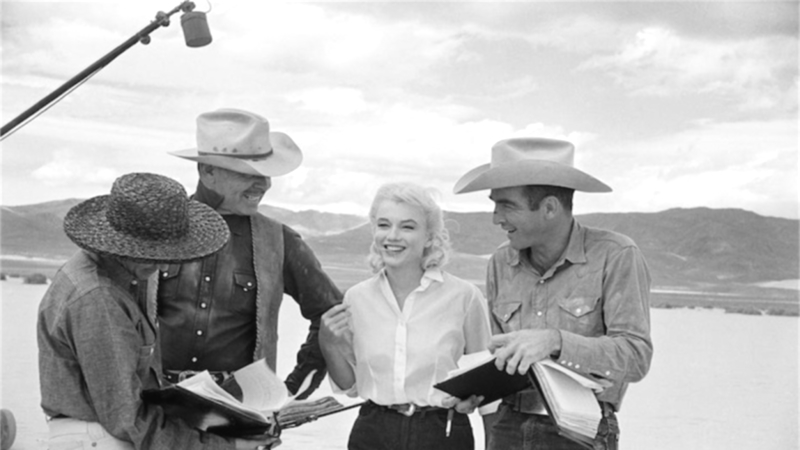
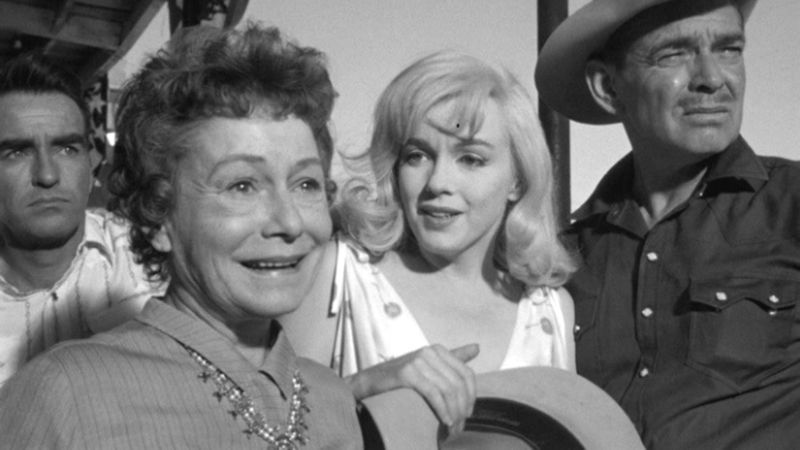
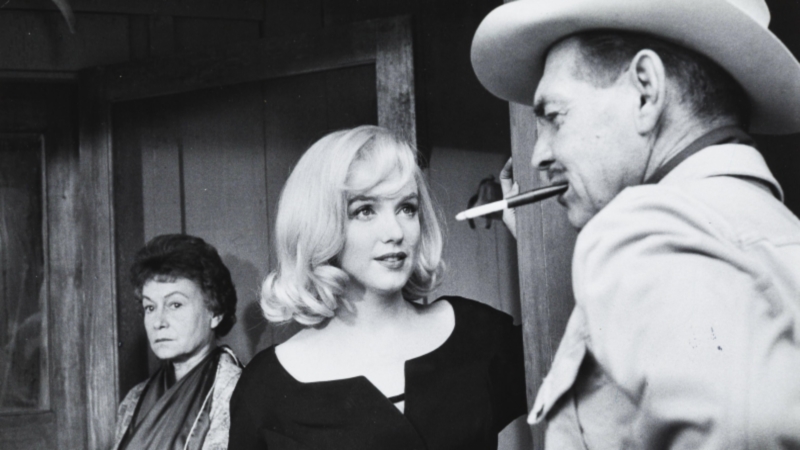
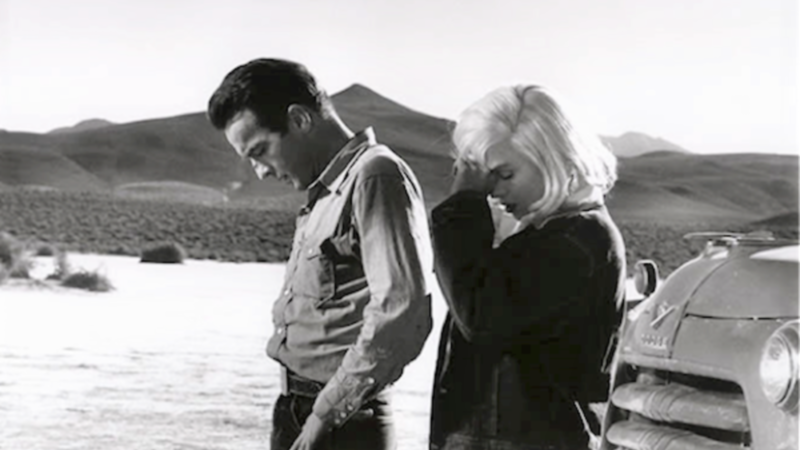
While The Misfits marks the end of an era, the end of an amazing decade of movie-making in Hollywood, as with most endings, it points to a beginning, a new era. A movie ahead of its time by approximately ten years, it also represents the demarcation when the Golden Age of Hollywood began its transformation. It earmarks the beginning of a time when the Golden Age morphed into the Lead Age, when movies became denser and heavier. After 1960, Hollywood slowly dismantled the censorship code in favor of a content ratings system and began to embrace sexuality and realism, the gritty and tough and often contradictory anti-hero. Hollywood, the City of Dreams, became less of a Star producing apparatus and briefly became a producer of movies as an artistic medium, began to value actors as artists, not just slaves to generate a cash flow stream. In short, movies became more real.
And it must be noted that Marilyn was a part of the vanguard creating this change. The one and only MM. Some will laugh at the preceding statement, laugh at my attribution of such an important status to a minor American actress, so judged by Gloria Steinem. In 1961, Jonas Mekas perceived something significant in Marilyn’s performance as Roslyn: he christened her Marilyn Monroe, the Saint of the Nevada Desert, writing:
She still remains there, a new screen character, MM, the saint. And she haunts you, you’ll not forget her. It is MM that is the film. A woman that has known love, has known life, has known men, has been betrayed by all three, but has retained her dream of man and love and life. Is MM playing herself or creating a part? Maybe she is even talking her own thoughts, her own life? Doesn’t matter much. There is such a truth in her little details, in her reactions to cruelty, to false manliness, nature, life, death—everything—that is overpowering, that makes her one of the most tragic and contemporary characters of modern cinema, and another contribution to The Woman as a Modern Hero in Search of Love.
In her final finished film, Marilyn Monroe, by virtue of her performance, transforms Roslyn, and by extension, herself, into an every woman who tells the truth and who fights for her dream, for the beautiful, innocent, and free and in the face of her deep suffering and pain, her disillusionment, still hopes and searches for true love. Now, you must concede, that is quite an accomplishment for a minor American actress.
